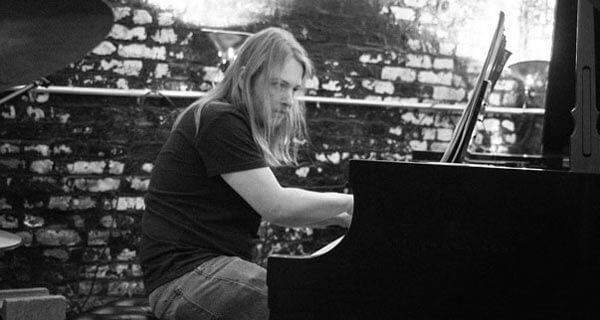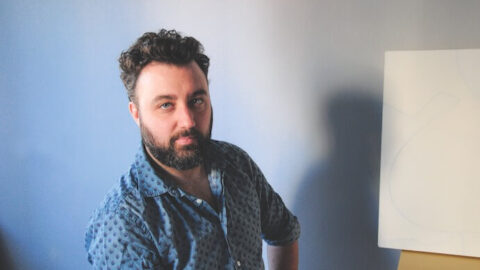Brooklyn composer Scott Wollschleger describes the piano as his “personal diary,” and his catalog includes many works for the instrument that explore themes of dystopia, synesthesia, and creative repetition. Last November, longtime collaborator Karl Larson performed the first half of Wollschleger’s complete piano works at Spectrum in New York, and on February 2nd, Larson will perform the second half. I asked Wollschleger 5 questions about the piano, collaboration, and original adjectives.
You have written a lot of music for piano in both solo and chamber works. What keeps you interested in writing for the piano?
Even though I can barely play it, the piano is often my best friend. I feel that activating the piano’s sustain pedal, playing a few notes and then listening to those notes fade away, is the equivalent of picking up the phone and speaking to someone you love. On a musical level, I think my interest in the piano is about harmony and decay. A lot of my piano music is based on various kinds of interaction in the way harmonies dissipate, fade away and overlap with each other. When the pedal is down, you are able to create beautiful fields of decaying sounds. It’s really about listening. So in my piano music, I think I’m trying to attenuate your ears to listening to the way the sounds fade away. I’m trying to compose a kind of song that’s always fading away. I think this approach probably comes out most clearly in Music Without Metaphor and Blue Inscription, both works will be presented on Karl’s February 2nd recital.

How did you and Karl begin collaborating? Has your collaboration changed your relationship to the piano?
I met Karl in 2012, and we immediately hit it off because we had very similar musical interest in what I guess you could call coloristic piano music. So music by composers like Feldman and Messiaen. We collaborated over the next few years on what shaped up to be my piano concerto, Meditation on Dust. One thing I love about Karl’s playing is his attention to voicing. In my clustery music, voicing is super important, and Karl is very sensitive to this. Karl is also extremely open-minded (and tolerant) of any crazy idea I come up with, either musically or philosophically, and I feel total artistic freedom when writing for Karl. I think working with Karl has allowed me to explore my musical ideas no matter how abstract they may become.
In dividing your piano repertoire into two halves for these performances, how did you decide the programs for each? Did this process uncover anything about these works as a whole?
Karl and I really were really thoughtful about giving a dramatic shape to each program. We went back and forth on coming up with what we felt were two shows that, in themselves, were complete musical experiences. Each one of my piano pieces is its own kind of self-contained world or is like a short story, so when placing the works in succession, there’s going to be an inevitable dramatic implication. We wanted to work with that. The pieces were written over the past 10 years, and the process of putting them all together has been very introspective. I think if anything, putting these two recitals together has made me incredibly grateful to have found Karl. I really feel that is he able to draw out the emotional core of each work.

Several of your pieces for different forces are titled with the word “Brontal” (including Brontal No. 2 and Brontal No. 6 on the February 2 program). Can you explain this word and the connections among the pieces that share it?
Brontal is an aesthetic concept and attitude that is about embracing the contradictions we encounter in our common experiences of everyday life. In my work, I try to forge and open up a new sense of reflection on these contradictions we live with. I think we can find beauty in the immediacy and the inherent utter strangeness of the world. I want to be able to walk through Walmart, and though I will feel intense despair, I also want to feel the sensation of colors happening in front of me. Almost anything in this sense can be Brontal. Perhaps Brontal is a kind of North American duende. Both “Brontal” pieces on the program are like these walks through Walmart, or a walk around New York City, and both works merge together intense grotesqueness with gentle tenderness. My dear friend and collaborator Anne Lanzilotti may have defined the word best in the liner notes for my recent album, Soft Aberration, writing “The word now embodies Wollschleger’s aesthetic: the idea that we can create something very basic and human by discovering the sensation of an object. In doing this, we are making something unfamiliar very immediate. This process of discovery can be very focused and also, at times, very funny.”
What’s fascinating you lately and informing your current composition projects, musically or otherwise?
The current political climate has no doubt accelerated a sense of urgency in my work, and for better or worse, I’ve been drawn to creating work the literally incorporates American life in the most banal of terms. So I’ve recently completed a solo speaking percussion work called Denny’s, which is about American cultural detritus. Another work I just finished for Anne Lanzilotti called Our Sense of the Real part IV is a piece that incorporates field recordings I made at various places I call home, and the work ends with a two-minute recording of an atomic bomb.
























